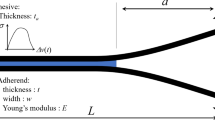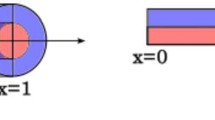Abstract
In this work we develop an adhesive zone model for polymeric interfaces, which describes the kinetics of dissociation and association of polymer chains bridging the interface. Compared with previous works on interfacial bond rupture, our adhesive zone model includes two novel features: possibility of bond reforming and a highly nonlinear force–extension relationship for the polymer chain motivated by previous experimental measurements. The absence of these two features was demonstrated in an earlier work to cause unphysical crack propagation under zero load as well as overextension of the chains beyond their full contour length. Using the rate dependent crack propagation in a double cantilever beam, which may be elastic or viscoelastic, as an example, the new adhesive zone model is shown to correct the unphysical results obtained earlier. Specifically, it leads to a significantly increased adhesive fracture energy, i.e., the energy per unit area required to rupture the chains on the interface, for slow crack propagation, owing to the ability to achieve a dynamic equilibrium of bond dissociation and association. Furthermore, the nonlinear chain model predicts a near-catastrophic decrease in chain density as the finite extensibility limit is approached. This results in an adhesive fracture energy which is orders of magnitude smaller than that predicted by the linear chain model for fast crack propagation. Although the adhesive zone model has only been applied to a double cantilever beam in this work, it is a generic model for polymeric interface, and can be implemented in finite element models to simulate fracture in bulk polymers in general.







Similar content being viewed by others
References
Andrews EH, Kinloch AJ (1973) Mechanics of adhesive failure I. Proc R Soc Lond A 332:385–399
Bell G (1978) Models for the specific adhesion of cells to cells. Science 12:618–627
Beyer MK, Clausen-Schaumann H (2005) Mechanochemistry: the mechanical activation of covalent bonds. Chem Rev 105:2921–2948
Chaudhury MK (1999) Rate-dependent fracture at adhesive interface. J Phys Chem B 103:6562–6566
Christiansen RM (2003) Theory of viscoelasticity, 2nd edn. Dover, New York
Evans E, Ritchie K (1997) Dynamic strength of molecular adhesion bonds. Biophys J 72:1541–1555
Gent AN (1996) Adhesion and strength of viscoelastic solids. Is there a relationship between adhesion and bulk properties? Langmuir 12:4492–4496
Gent AN, Schultz J (1972) Effect of wetting liquids on the strength of adhesion of viscoelastic material. Adhesion 3:281–294
Ghatak A, Vorvolakos K, She H, Malotky DL, Chaudhury MK (2000) Interfacial rate processes in adhesion and friction. J Phys Chem B 104:4018–4030
Hanggi P, Talkner P, Michal B (1990) Reaction-rate theory: fifty years after Kramers. Rev Mod Phys 62:251–342
Hui CY, Xu DB, Kramer EJ (1992) A fracture model for a weak interface in a viscoelastic material (small scale yielding analysis). J Appl Phys 72(8):3294–3304
Hui CY, Tang T, Lin YY, Chaudhury MK (2004) Failure of elastomeric polymers due to rate dependent bond rupture. Langmuir 20:6052–6064
Kramers HA (1940) Brownian motion in a field of force and the diffusion model of chemical reactions. Physica VII:284–304
Lake GJ, Thomas AG (1967) The strength of highly elastic materials. Proc R Soc Lond A 300:108–119
Lavoie SR, Long R, Tang T (2015) Rate dependent fracture of a double cantilever beam with combined bulk and interfacial dissipation. Int J Solids Struct. doi:10.1016/j.ijsolstr.2015.08.020
Nguyen TD, Govindjee S (2006) Numerical study of geometric constraint and cohesive parameters in steady-state viscoelastic crack growth. Int J Fract 141:255–268
Rahulkumar P, Jagota A, Bennison SJ, Saigal S (2000) Cohesive element modeling of viscoelastic fracture: application to peel testing of polymers. Int J Solids Struct 37:1873–1897
Rajagopal KR, Wineman A (1992) A constitutive equation for nonlinear solids which undergo deformation induced microstructural changes. Int J Plast 8:385–395
She H, Malotky D, Chaudhury MK (1998) Estimation of adhesion hysteresis using rolling contact mechanics. Langmuir 14:3090–3100
Wineman A (2009) On the mechanics of elastomers undergoing scission and cross-linking. Int J Adv Eng Sci Appl Math 1:123–131
Wojtecki RJ, Meador MA, Rowan SJ (2011) Using the dynamic bond to access macroscopically responsive structurally dynamic polymers. Nat Mater 10:14–27
Xu DB, Hui CY, Kramer EJ (1992) Interface fracture and viscoelastic deformation in finite size specimens. J Appl Phys 72(8):3305–3316
Acknowledgments
The authors acknowledge financial support from the Natural Science and Engineering Research Council (NSERC), Canada Foundation for Innovation and Alberta Innovates Technology Futures.
Author information
Authors and Affiliations
Corresponding author
Electronic supplementary material
Below is the link to the electronic supplementary material.
Rights and permissions
About this article
Cite this article
Lavoie, S.R., Long, R. & Tang, T. An adhesive zone model for polymeric interfaces. Int J Fract 197, 169–183 (2016). https://doi.org/10.1007/s10704-016-0073-2
Received:
Accepted:
Published:
Issue Date:
DOI: https://doi.org/10.1007/s10704-016-0073-2




